Content
The Berkeley Tie Dye Heart tomato is an indeterminate variety characterized by large fruits. It got its name due to its unusual coloring. The technique of dyeing canvases involves obtaining blurred stripes and strokes on the fabric, the same as those present on these varietal tomatoes.
History of selection
Berkeley Tai Dai Haat was bred in the USA by breeder Brad Gates. The variety was obtained by crossing Tai Dai and Haat.
Description of the Berkeley tomato Thai Dai Haat
Berkeley Tai Dai Haat is a hybrid of foreign selection with unlimited growth, bearing fruit throughout the season. The bush reaches a height of 1.8-2 m. 5-8 brushes are formed on it, in which the ovaries are located. Each of them has 4-5 fruits.
The tomato has a rich sweetish taste and pronounced aroma. Each fruit weighs from 150 to 400 g. The pulp is oily, dense and fleshy, with a small number of seeds.
Tomatoes at the stage of full ripeness are distinguished by a peculiar red-brown color, including the presence of greenish strokes. At the same time, characteristic stripes are also present on unripe fruits.

At the stage of technical ripeness, tomatoes are dark yellow.
Characteristics of the Berkeley tomato Thai Dai Haat
The tomato is a mid-early variety. When grown in open ground, the growing season averages 105 days.
The harvest is harvested from mid-summer to early autumn. It is recommended to pick tomatoes at a time when they are at the stage of technical ripeness, since the taste of ripe fruits slightly deteriorates.
Tomato yield Berkeley Tai Dai Haat
The Berkeley tomato Tai Dai Haat is considered a high-yielding variety. From one bush, when growing a plant in a greenhouse, it is possible to collect about 3 kg of fruit.

When grown indoors, tomatoes ripen about 20 days earlier
Resistance to diseases and pests
The plant has strong immunity. Diseases develop when agricultural practices are not followed. Tomato is quite resistant to attacks from harmful insects.
Methods of application
Tomatoes can be eaten fresh or used for drying. The fruits are also suitable for cooking:
- second courses;
- snacks;
- juices;
- sauces;
- pasta.
Advantages and disadvantages
The tomato adapts well to different climatic conditions, but does not tolerate sudden temperature changes.

The inside of the Berkeley Thai Dai Haat tomato contains virtually no juice.
Pros:
- good keeping quality (about 20 days after collection);
- high productivity;
- can be grown in open and closed ground;
- excellent taste;
- not susceptible to attacks by harmful insects;
- has strong immunity;
- versatility;
- early maturation;
- attractive appearance;
- excellent germination;
- large-fruited.
Minuses:
- excessive vegetation.
Features of planting and care
The recommended time for planting seeds is the first ten days of March. It is advisable to use peat pots measuring 8x8 cm for growing seedlings. They will need to be pre-filled with a soil mixture, which is made up of the following components:
- 5 parts peat;
- 3 parts humus;
- 1 part each of turf soil and mullein.
Tomato seeds should be placed in pots and covered with film on top. After three true leaves appear, it is recommended to pick.
The seedlings are moved to the garden bed at the age of 55 days. The recommended distance between plants is 60 cm.

It is advisable to place no more than three tomato bushes per 1m2, the optimal depth of each hole is 40 cm
Tomatoes of this variety need a garter, since the branches can break under the weight of the fruit. Therefore, at the stage of transplanting seedlings, a small wooden stick or metal pole should be placed next to each bush to a depth of 30-40 cm.
Before planting seedlings, it is recommended to dig up the beds and fertilize them with organic matter at the rate of 0.5 buckets per 1 m2. It is also advisable to add 30 g of superphosphate and 15 g of potassium salt.
Caring for a tomato of this variety involves watering and pinching, as well as timely application of fertilizers.Plants will also need to be tied to installed supports using fabric or special clips.
Water the tomato as soon as the soil dries out. Recommended water temperature is from +18 to +25 °C. The liquid should be poured strictly at the root. It is recommended to water in the early morning or after sunset.

During the growth of ovaries, the soil should be moistened every six days
It is recommended to plant the Berkeley Thai Dai Haat tomato once every 14 days. During the procedure, it is not advisable to remove the stepson completely. Be sure to leave a small stump measuring 1.8 cm. Plants are formed into 1-2 stems. The lower leaves are removed when the tomatoes ripen into two clusters.
It is recommended to feed tomatoes throughout the season. Fertilizer application procedure:
- During active tomato growth. Fertilizing helps strengthen the root system and promotes the growth of green mass. It is recommended to use nitrogen and phosphate fertilizers.
- During flowering. Phosphorus and potassium fertilizers should be applied to stimulate fruit set.
- During fruiting. This period is the most difficult for tomatoes, so it is recommended to fertilize twice. The plant needs microelements such as potassium, boron and iodine. The preferred fertilizers are mullein, potassium sulfate and boric acid.
Pest and disease control
If the rules of agricultural technology are not followed, the Berkeley Tai Dai Haat tomato can develop fungal diseases such as late blight, crown and root rot and brown spot.

Overwatering leads to the development of brown spotting in tomatoes, which causes brown spots and a silvery coating to appear on the leaves.
To combat fungal infections, it is recommended to use Ordan and Fundazol. Infected bushes can also be sprayed with a solution containing copper or Bordeaux mixture. Treatment is effective only when the first signs of the disease are detected. If the plant is severely affected, then the bush along with the fruits will have to be disposed of.
Tomatoes are extremely rarely attacked by pests. But once a season it is recommended to carry out preventive treatment. It is advisable to use a solution of sodium humate at the rate of 10 ml per bucket of water. It is advisable to carry out the procedure when the buds appear.
Conclusion
The Berkeley tomato Tai Dai Haat is a versatile variety that grows quickly. With minimal care, it is possible to harvest a rich harvest of large and fragrant fruits on time.
Reviews from gardeners about the Berkeley tomato Tai Dai Haat
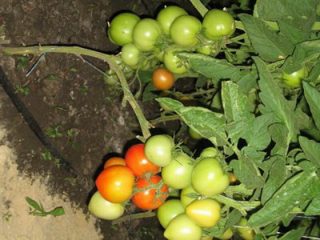

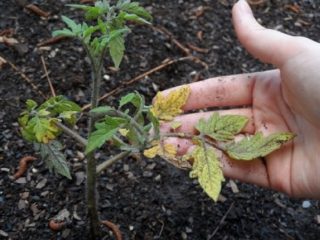
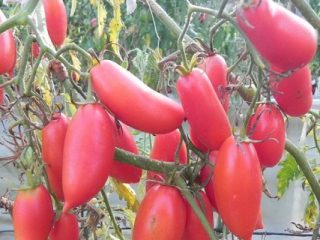
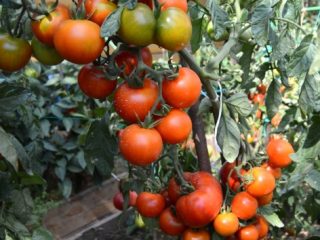
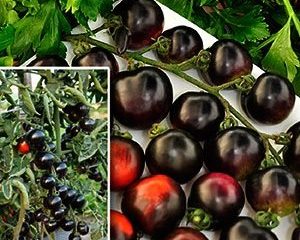
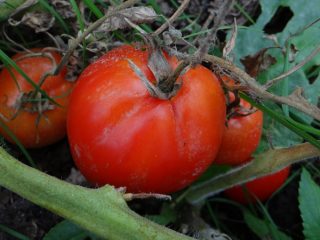
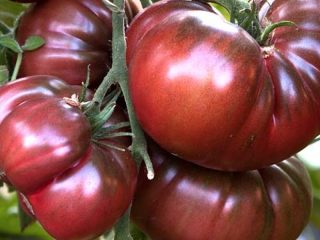
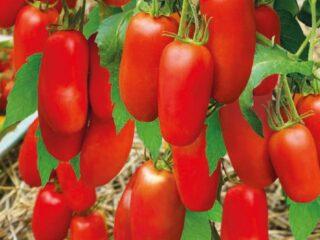
I planted it for the first time on "maybe". There is no greenhouse, everything is in exhaust gas. Just three bushes. Tomatoes are unusual in color. It seems I picked them too late. I read what is needed for technical ripeness, but they are already soft. I’ll just dry it, my family loves it. But I'll try it myself.